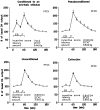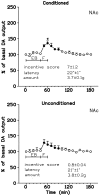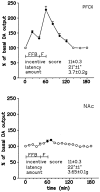Differential influence of associative and nonassociative learning mechanisms on the responsiveness of prefrontal and accumbal dopamine transmission to food stimuli in rats fed ad libitum
- PMID: 8987806
- PMCID: PMC6573251
- DOI: 10.1523/JNEUROSCI.17-02-00851.1997
Differential influence of associative and nonassociative learning mechanisms on the responsiveness of prefrontal and accumbal dopamine transmission to food stimuli in rats fed ad libitum
Abstract
Feeding a novel food (Fonzies) to rats fed ad libitum with standard food increased extracellular dopamine (DA) in the medial prefrontal cortex (PFCX) and in the medial nucleus accumbens (NAc). Previous Fonzies feeding, although it did not affect the increase of extracellular DA in the PFCX in response to Fonzies feeding, blunted that increase in the NAc (habituation); recovery from habituation in the NAc was complete 5 d after previous Fonzies feeding. Predictive association of an otherwise neutral stimulus extrinsic to Fonzies (empty plastic box) with Fonzies feeding resulted in the acquisition by the stimulus of the property to elicit incentive responses directed toward the stimulus and to increase extracellular DA in the PFCX. However, the same stimulus, or a more complex stimulus including intrinsic stimuli (Fonzies-filled plastic box), failed to acquire the ability to modify extracellular DA in the NAc. Pseudoconditioning, i.e., nonpredictive association of the extrinsic stimulus (empty box) with Fonzies feeding, did not result in acquisition by the stimulus of the property to elicit incentive responses and to increase extracellular DA in the PFCX. Repeated nonreinforced presentation of previously conditioned extrinsic stimuli (empty box) resulted in extinction of the property to elicit incentive responses and to increase extracellular DA in the PFCX. These results indicate that in rats fed ad libitum, phasic activation of mesocortical and mesolimbic DA systems by motivational stimuli is differentially influenced by associative (conditioning) and nonassociative (habituation) learning mechanisms and is differentially related to acquisition and expression of incentive motivation.
Figures








References
-
- Abercrombie ED, Keefe KA, DiFrischia DS, Zigmond MJ. Differential effect of stress on in vivo dopamine release in striatum, nucleus accumbens, and medial frontal cortex. J Neurochem. 1989;52:1655–1658. - PubMed
-
- Bassareo V, Tanda G, Petromilli P, Giua C, Di Chiara G. Non-psychostimulant drugs of abuse and anxiogenic drugs activate with differential selectivity dopamine transmission in the nucleus accumbens and in the medial prefrontal cortex of the rat. Psychopharmacology. 1996;124:293–299. - PubMed
-
- Beninger RJ. The role of dopamine in locomotor activity and learning. Brain Res Rev. 1983;6:173–196. - PubMed
-
- Berger B, Gaspar P, Verney C. Dopaminergic innervation of the cerebral cortex: unexpected differences between rodents and primates. Trends Neurosci. 1991;14:21–27. - PubMed
-
- Berridge KC. Food reward: brain substrates of wanting and liking. Neurosci Biobehav Rev. 1996;20:1–25. - PubMed
Publication types
MeSH terms
Substances
LinkOut - more resources
Full Text Sources
